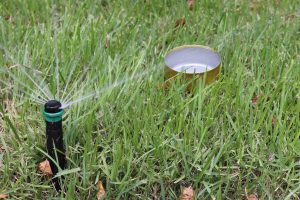By Brooke Moffis
Does the drought have you scratching your head and wondering what to do about your lawn and landscape? Are you like me, ready to perform a rain dance to help your garden simply survive? If so, you can give your lawn and landscape the best chance of health and survival until summer rains begin by following drought management practices.
By implementing a few simple changes to your lawn maintenance practices, lawns can better survive a drought. First, raise those mower blades to maintain your turf at the proper height and try not to scalp it when stressed for water. This means removing no more than a third of the leaf blade at any time. Mow at heights around 3.5 to 4 inches for St. Augustinegrass and bahiagrass. The longer the leaf blade, the longer the root system and the more drought tolerant your turf will become.

Irrigation systems should deliver no more than ½” to ¾” per watering. Irrigating in this way will allow you to water one to two times per week or even less if, the turf is not showing signs of stress. When deciding whether to irrigate, look for leaf blades folding up and a blue-green cast to the lawn. When tire marks or footprints remain on the lawn after you walk or drive across, it indicates it is time to water. Only water when needed.
Delay the use of fertilizers and herbicides in your landscape until drought conditions have improved. Salts from fertilizers and herbicides can burn stressed turfgrass. Lawn and landscape companies can still use fertilizers during this time if they apply it at a reduced rate, but even they will have to minimize their herbicide use. Pesticides can be used, but only as a spot treatment and if the pest problem warrants control, but avoid using insecticides over an entire lawn. By minimizing applications of these products, you will minimize additional stress on the turfgrass.
Plant Selection
When the drought is over consider planting landscape plants with minimal water requirements. Groundcovers such as perennial peanut, Asiatic jasmine and sunshine mimosa need to be watered frequently after planting, but only need occasional watering once they are established.
When selecting lawn and landscape plants consider your site conditions and plant the right plant in the right place. This is the first step in the University of Florida’s Florida-Friendly LandscapingTM Program. A listing of other drought tolerant plants can be found in the publication Drought-Tolerant Plants for North and Central Florida.
 0
0
